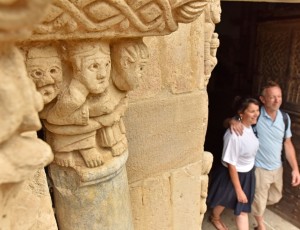Issoire, gateway to the South
Issoire, a town in Auvergne with 15 000 habitants, is ideally located in the Puy-de-Dôme department, in the plains and at the confluence of the River Allier and the Couze Pavin. 25 minutes south of Clermont-Ferrand, Issoire is not far from the A75 motorway, along which thousands of holidaymakers drive south each year. In fact, Issoire has been called the gateway to the south because of its highly colourful architecture, tile roofs, and mild and sunny climate. For centuries it has been known as a “fine Auvergne town”, famous as a place for trade and fairs. Today, the richness of its material and immaterial heritage has earned it the “Most Beautiful Detour in France” label.
The star of Issoire: Saint-Austremoine abbey church
To visit Issoire at your own pace, ask for the “town walk” brochure at the Tourist Office.
The 12th century edifice is one of the five major Romanesque churches in Lower Auvergne. Built in gilded arkose stone from the town of Montpeyroux, it is the biggest Romanesque church in Auvergne: 65 metres long, 18 metres high under the vault and 23 metres high under the dome. Outside, the chevet always impresses visitors. Made up of five radiating chapels, an ambulatory, choir, a barlong structure and the lantern tower (rebuilt in the 19th century), these different structures form a rising terrace and pyramid that is typical of Romanesque churches in Auvergne. A collection of two-coloured stone mosaics and a zodiac cycle in the form of 13 sculpted medallions complete the decoration. The thirteenth medallion at the corner of the southern transept is intriguing – perhaps you will have your own interpretation! Inside, the multi-coloured frescoes covering the walls of the abbey church, and the capitals with their narrative scenes never fail to surprise visitors.
To round off your visit, the Georges Duby Romanesque art centre in the vaulted rooms of the former Benedictine abbey organises exhibitions on themes linked to Romanesque art.
A stroll through Issoire
The old town has kept its original layout, with today’s avenues replacing yesterday’s fortifications. As you stroll through the streets, you will see the Clock Tower, the former town belfry, built in the 15th century, with a Volvic stone façade dating from 1840. Exhibitions are held here throughout the year and the belvedere provides a unique view over the town and the surrounding hills: the Sancy, the Puys mountains, Le Cézallier. While walking through the labyrinthine streets of Issoire, you will see several private mansions from the 15th and 18th centuries, such as the Hôtel Bohier, Hôtel Clément or the Maison Bartin. At the heart of the town, the colourful Place de la République comes to life for a magnificent market every Saturday morning.
Water and parks
Thanks to the nearby Couze Pavin, the town has benefitted from a major water network for a number of centuries. You are likely to come across the biefs or canals that supply water to orchards, meadows and parks. In summer, René Cassin Square, with the Couze Pavin running through it, opposite the abbey church, provides a pleasant and refreshing break. 600 metres from the town centre, the château d’Hauterive, dating from the 17th and 18th centuries, has parks with the “Remarkable Gardens” label. Here you can enjoy an agreeable stroll through French-style gardens, terraced vegetable gardens and cabinets de verdure (“closets of green”). You can also visit outbuildings (bakery, fermentation room, cellar, ice room).
Industrial history
Issoire owes its dynamism to the many industries based here. During the 20th century, the town came to specialise in two industries: cars and aeronautics. Issoire was also the home for a time of the motor bike manufacturer Voxan, known for its original designs and v-twin engine, with an angle of 72° and 1000 cm³.

 UK
UK
 FR
FR











